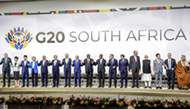[한글 번역] On the Steppes, Mongols Revisit Nomadic Roots
KHUI DOLOON KHUDAG, Mongolia - The boy rode the stallion in a trot around the camp, cooling it down after a long gallop across the steppe. He was humming his favorite Mongolian hiphop songs .
Nearby, in the family’s round felt tent, the boy’s father ran a wire from a satellite dish to a big-screen television. His mother paced around in high-heeled boots.
“When I’m in the city, I miss my horses,” the boy, Munkherdene, 13, said. “When I’m in the countryside, I miss my friends and games. I really miss my PlayStation.”
Such is the life of a city boy turned child jockey in the wilds of Mongolia.
Munkherdene and his family, who like most people here go by their given names, are among a growing number of Mongolians from the traffic-choked capital, Ulan Bator, trying to get back to their nomadic roots. The boy’s father is a successful businessman, importing electronics, bicycles and mining equipment from Japan. But like many affluent Mongolians these days, he also breeds racehorses.
“This summer, I was going to send him to Singapore to improve his English,” the father, Enkhbayar, 49, said of his son. “But he decided to stay with me to help with the horses.”
Horse racing is becoming an industry across the same Central Asian steppes where Genghis Khan and his warrior hordes once galloped. The biggest race of the year took place on July 11, 48 kilometers west of the capital.
It is part of the annual Naadam Festival, a gathering that matters more to Mongolians than the Olympics. Children as young as 5 ride in races that can be dangerous, with hundreds of horses thundering across the open plain at once, running at speeds approaching 80 kilometers per hour.
As the competition intensifies, businessmen are importing larger horses from foreign lands to breed with the small Mongolian horses, the prize money is getting heftier and owners are transporting horses to competitions in trucks and trailers rather than riding them.
Other traditions are changing, too. Horse racing is among what Mongolians call the “three manly sports” (alongside wrestling and archery), but female jockeys have started to appear.
Munkherdene and Enkhbayar spend their summers traveling across the country from race to race, sleeping in the family’s traditional tent, or ger, one that cost thousands of dollars . “The best thing is the air, and horse riding, and when it rains,” Munkherdene said.
For the race, the family set up two gers, one for sleeping and another for cooking. Their eight racehorses were tethered to posts, brought here by a half-dozen men hired as trainers. The family owns more than 100 horses . A racehorse costs anywhere from $300 to more than $80,000, Enkhbayar said.
Enkhbayar, a father of four, watched as Munkherdene jumped off the stallion and hitched it to a post. He seems like any 13-year-old boy from any world capital. Last month, he stayed up late to watch matches of the Euro 2008 soccer tournament. His favorite PlayStation games are NBA Street and FIFA Street.
Prize money can be big by Mongolian standards. The top prize at Naadam is 1,000,000 togrog, or $870.
Munkherdene’s horse finished 78th out of more than 200 at Naadam. “I’m not happy,” Munkherdene said. “I’m very unhappy. I wanted my horse to be among the top five.
“The trainer didn’t train the horse well,” Munkherdene said.
Munkherdene said he would race this summer in smaller competitions. Then he will go home to Ulan Bator to his friends and his PlayStation.
대초원에서 유목민 뿌리 찾는 몽고 사람들
몽고, 쿠이 돌룬 쿠닥에서 에드워드 웡 기자
소년은 대초원을 가로 질러 오래 달리게 한 다음 캠프 주위를 빨리 걷게 하여 종마의 열을 식힌다. 그러면서 몽고 힙합 노래들을 흥얼거린다.
그 근처에 자리잡은 이 가족의 둥근 펠트 텐트 안에서는 소년의 아버지가 위성 접시에 연결된 전선을 대형 스크린 텔리비전에 연결시키고 있다. 그의 어머니는 굽 높은 장화를 신고 걸어 다닌다.
“도시에 있을 때는 말들이 보고 싶어요”라고 말하는 이 소년 문케르데네는 13세다. “시골에 있을 때는 친구와 게임이 그리워요, 플레이스테이션이 정말 하고 싶어요”
그것이 몽고의 황야를 달리는 어린이 기수가 된 도시 소년의 삶이다.
이곳에 사는 대부분의 사람들과 마찬가지로 성 없이 이름만으로 통하는 문케르데네와 그의 가족들처럼 교통때문에 숨 막히는 이 나라 수도 울란 바토르 주민 중에는 유목민의 뿌리로 돌아가려는 사람들이 많아지고 있다. 소녀의 아버지는 일본에서 전자제품, 자전거와 채굴장비를 수입하는 성공한 사업가지만 요즘 많은 부유한 몽고인들과 마찬가지로 경주마를 사육하고 있다.
“올 여름엔 싱가포르로 보내서 영어 공부를 시키려 했지만 내 곁에 남아 말을 돌보겠다네요라고 소년의 아버지 엔크바야르(49)는 아들에 대해 말했다.
칭기스칸과 그의 전사들의 무리가 달렸던 같은 중앙 아시아의 대초원 전역에 걸쳐 경마는 하나의 기업이 되고 있다. 올해 최대의 경주는 7월 11일, 수도에서 48킬로미터 서쪽에서 열렸다.
몽고 사람들에게 올림픽보다 더 중요한 모임인 연례 나담 축제의 일환이다. 다섯살짜리까지 포함한 아이들이 탄 수백마리의 말이 한꺼번에 광활한 평원으로 우뢰와 같은 소리를 내며 출발해 시속 80킬로미터에 육박하는 속도로 내닫는 이 경주는 위험할 수도 있다.
경쟁이 강화되고 사업가들이 조그만 몽고 말과 교배시키기 위해 외국에서 더 큰 말을 수입해오면서 상금도 더 많아지고 있고, 경기에 출전시킬 말들도 주인이 타고 가기보다 트럭과 트레일러로 수송되고 있다.
다른 전통들 또한 변화하고 있다. 경마는 씨름, 활쏘기와 함께 몽고 사람들이 꼽는 3대 남성 스포츠이지만 여자 기수들도 나타나기 시작했다.
문케르데네와 엔크바야르도 여름이면 경마대회를 따라 전국을 누비고 다니며 몇천달러나 들인 이 가족의 전통 천막 게르에서 잠을 잔다. “제일 좋은 건 공기, 말타기, 그리고 비가 올 때”라고 문케르데네는 말했다.
대회용으로 이 가족은 게르 두개를 치는데 하나는 취침, 다른 하나는 취사용이다. 조련사로 고용된 남자 6명이 가져온 그들의 경주마 8마리는 말뚝에 매어있다. 이 가족은 말을 100마리 이상 소유하고 있는데 경주마 값은 300달러부터 8만달러 이상까지 나간다고 엔크바야르는 말했다.
4자녀의 아버지인 엔크바야르는 문케르데네가 종마에서 뛰어 내려 말을 말뚝에 묶는 것을 바라본다. 아이는 세상 여느 곳의 13세 소년과 다르지 않아 보인다. 지난 달엔 밤 늦게까지 유로 2008 축구 토너먼트 경기들을 지켜봤다. 그가 좋아하는 플레이스테이션 게임은 NBA 스트릿과 FIFA 스트릿이다.
상금은 몽고 기준으로는 상당히 크다. 나담의 일등상은 100만 토그로그, 즉 870달러다.
문케르데네의 말은 나담에서 200여마리중 78등을 했다. “만족스럽지 않아요. 정말 기분 나빠요. 내 말이 5등안에 들기를 바랐거든요”라고 문케르데네는 말했다.
“조련사들이 말을 잘 훈련시키지 못했어요”
문케르데네는 올 여름 작은 규모의 경마대회들에 출전하고나서 친구와 플레이스테이션이 있는 울란바토르의 집으로 갈 예정이다.
어휘 해설
steppe 스텝 《나무가 없는, 특히 시베리아의 대초원》
gallop 질주하다
trot <말 등이> 빠른 걸음으로 가다, 총총 걸음으로 가다
wilds 황무지, 황야;미개지
given names 이름
nomadic 유목의, 방랑의
racehorse 경주마
Genghis Khan칭기즈칸《원나라의 태조;몽골 제국의 시조》
horse racing 경마
wrestling 레슬링, 씨름, 격투
archery 궁술
ger 게르, 몽골족의 이동식 집. 높이 1.2m의 원통형 벽과 둥근 지붕으로 되어 있다. 벽과 지붕은 버들가지를 비스듬히 격자로 짜서 골조로 하고, 그 위에 펠트를 덮어 씌워 이동할 때 쉽게 분해 ·조립할 수 있다.
jump off ~에서 뛰어내리다
스마터리빙
more [ 건강]
[ 건강]이제 혈관 건강도 챙기자!
[현대해운]우리 눈에 보이지 않기 때문에 혈관 건강을 챙기는 것은 결코 쉽지 않은데요. 여러분은 혈관 건강을 유지하기 위해 어떤 노력을 하시나요?
 [ 건강]
[ 건강]내 몸이 건강해지는 과일궁합
 [ 라이프]
[ 라이프]벌레야 물럿거라! 천연 해충제 만들기
 [ 건강]
[ 건강]혈압 낮추는데 좋은 식품
[현대해운]혈관 건강은 주로 노화가 진행되면서 지켜야 할 문제라고 인식되어 왔습니다. 최근 생활 패턴과 식생활의 변화로 혈관의 노화 진행이 빨라지고
사람·사람들
more
김응화 단장, 아쿠아리움 퍼시픽 ‘헤리티지 어워드’
김응화무용단의 김응화 단장이 롱비치의 아쿠아리움 오브 더 퍼시픽이 수여하는 2025년 ‘헤리티지 어워드’의 영예를 안았다. 올해 처음 개최된 …

이정임 무용원, 팬아시아 전통예술 경연대회
남가주 최대 규모의 아시아 전통 예술 경연대회인 팬아시아 댄스 앤 드럼 대회에서 이정임무용원의 청소년 단원들이 경연에 참가해서 전체 대상 등 …
유희자 국악무용연구소, 팬아시아 전통예술대회
지난 15일 샌개브리얼 셰라톤 호텔에서 열린 남가주 최대 규모의 전통 무용대회인 팬아시아 댄스 앤 드럼 대회에서 유희자 국악무용연구소(원장 유…
송년행사 안내해드립니다
다사다난했던 2025년이 이제 종착점을 향해 달려가고 있습니다. 한 해를 잘 마무리하고 2026년 새해를 힘차게 맞기 위한 다짐을 하는 송년 …
‘군중’ 시리즈 이상원 작가 첫 LA전시회
아케디아 소재 홈갤러리인 ‘알트프로젝트’(대표 김진형)가 오는 29일(토)부터 한국 블루칩 작가 이상원이 참여하는 전시 ‘인 드리프트(In D…
많이 본 기사
- ‘쿠데타 모의’ 브라질 前대통령 징역형 집행 하루 전 체포
- 딥페이크 사기에 가장 많이 악용된 스타는 테일러 스위프트
- 사과·尹절연 포함될까…국힘, ‘비상계엄 1년’ 메시지 수위 고심
- ‘당정대 삼각편대’ 정청래·김민석·강훈식…주목되는 광폭 행보
- 시카고서 10대 집단난동 중 총격…트… 1
- 임시정부가 펴낸 ‘한일관계사료집’ 복원 거쳐 공개된다
- AI탑재 곰인형이 성관계·약물 대화까지?…美 소비자단체 경고
- [특파원 시선] 트럼프도 떨게만든 물가…정책 유턴 신호탄될까
- 한덕수 재판서 드러난 ‘계엄의 밤’…내란 첫 법적판단 나온다
- 이지혜, 인중축소술 후 “남편이 하향세 탈거라 저주”→ “존재 자체로 우린 특별해” 멘탈 잡는 중
- 美 주도 종전안에 유럽 정상들 “재논의 필요”…신중·의구심
- 성시경, 매니저 배신에 끝내 눈물.. “너무 힘들지만 마음 다잡아”
- 트럼프, 측근이었다 등돌린 의원 사임 발표에 “지지율 급락 탓”
- 조영구, 주식으로 21억 잃었는데 ‘10억’ 집값도 하락 “미용실서 아줌마 말 듣고 분양”
- 역사적인 누리호 4차 발사 ‘카운트다운’…관람 명당 각광
- ‘세계 최강’ 최민정, 월드투어 전종목 1위 예선 통과... 金 싹쓸이 정조준
- ‘부친 빚투 논란’ 김혜성 “순간 감정 추스르지 못해, 깊이 반성한다” 사과문 공개
- “美, 23일 제네바서 우크라와 종전안 논의…루비오 등 참석”
- 트럼프, 우크라 평화구상에 “우크라에 대한 최종제안 아니다”
- 뉴욕증시 거품 우려에 격동의 한 주… “월가, 더 큰 혼란 대비”
- ‘김건희 계좌 관리인’ 도이치 주가조… 1
- “로봇이 사람 두개골 깰 수 있어”…피겨AI, 前직원에 피소
- ‘단 1승이면 전설이 된다’ 안세영, 호주오픈 결승 진출... 女 배드민턴 단식 최다승 경신 도전
- 李대통령 “통일 노하우 알려달라”…獨총리 “北 궁금한 것 많아”
- 푸틴 특사 “트럼프 평화 계획은 우크라 구하기 위한 것”
- 美 빠진 유엔기후총회 ‘화석연료’ 언급 빠진 선언문 내고 종료
- “트럼프 종전 압박, 우크라 ‘부패 스캔들’ 약점 노린 듯”
- “트럼프 정부, 대법 패소 대비 대체 관세 수단 준비”
- G20 정상회의 첫날부터 ‘남아공 정상선언’ 전격 채택
- 李대통령, G20 정상회의 둘째날… ‘AI시대’ 국제협력 구상 밝힌다
- ‘케데헌’, 오스카 애니메이션상 후보자격 갖춘 35편에 포함
- 미중 해군 실무회의…中 “주권·안전 위협행위 단호히 반대”
- ‘김민재 위기! 안 그래도 제 3센터백인데’ 강력 경쟁자 日 이토, 복귀 임박했다... “몇 달간 중요한 기둥될 것”
- 李대통령, ‘선순환재정·다자무역·개발협력’…포용성장 3大제안
- 남아공서 아프리카 첫 G20 개막… ‘美 보이콧’ 극복 관심
- “日, 내년 1월 한중일 정상회의 개최 韓·中에 타진…中 거부”
- EU, 미국에 파스타·치즈·와인 관세 면제 요구
- CDC ‘백신은 자폐증 유발 안한다’ 입장 변경…보건장관 지시
- 변종 조류독감 최초 감염자 사망…워싱턴 보건당국 “대중 위험 낮아”
- LA항 대형 컨테이너선 화재…일부 터미널 운영 중단
1/5지식톡

-
 테슬라 자동차 시트커버 장착
0
테슬라 자동차 시트커버 장착
0테슬라 시트커버, 사놓고 아직 못 씌우셨죠?장착이 생각보다 쉽지 않습니다.20년 경력 전문가에게 맡기세요 — 깔끔하고 딱 맞게 장착해드립니다!장착비용:앞좌석: $40뒷좌석: $60앞·뒷좌석 …
-
 식당용 부탄가스
0
식당용 부탄가스
0식당용 부탄가스 홀세일 합니다 로스앤젤레스 다운타운 픽업 가능 안녕 하세요?강아지 & 고양이 모든 애완동물 / 반려동물 식품 & 모든 애완동물/반려동물 관련 제품들 전문적으로 홀세일/취급하는 회사 입니다 100% …
-
 ACSL 국제 컴퓨터 과학 대회, …
0
ACSL 국제 컴퓨터 과학 대회, …
0웹사이트 : www.eduspot.co.kr 카카오톡 상담하기 : https://pf.kakao.com/_BEQWxb블로그 : https://blog.naver.com/eduspotmain안녕하세요, 에듀스팟입니다…
-
 바디프렌드 안마의자 창고 리퍼브 세…
0
바디프렌드 안마의자 창고 리퍼브 세…
0거의 새제품급 리퍼브 안마의자 대방출 한다고 합니다!8월 23일(토)…24일(일) 단 이틀!특가 판매가Famille: $500 ~ $1,000Falcon: $1,500 ~ $2,500픽업 & 배송직접 픽업 가능LA…
-
 바디프렌드 안마의자 창고 리퍼브 세…
0
바디프렌드 안마의자 창고 리퍼브 세…
0거의 새제품급 리퍼브 안마의자 대방출 한다고 합니다!8월 23일(토)…24일(일) 단 이틀!특가 판매가Famille: $500 ~ $1,000Falcon: $1,500 ~ $2,500픽업 & 배송직접 픽업 가능LA…
케이타운 1번가
오피니언
 조지 F·윌 워싱턴포스트 칼럼니스트
조지 F·윌 워싱턴포스트 칼럼니스트 [조지 F. 윌 칼럼] 세계를 가장 크게 바꾼 사건, 미국 혁명전쟁
 이희숙 시인·수필가
이희숙 시인·수필가 [금요단상] 낙엽 위에 남겨진 향
 김정곤 / 서울경제 논설위원
김정곤 / 서울경제 논설위원[만화경] ‘중동판 꽌시’ 와스타

[왈가 왈부] ‘패트 충돌’ 선고에 여야 “정치 판결” “자성 촉구” 아전인수?
 수잔 최 한미가정상담소 이사장 가정법 전문 변호사
수잔 최 한미가정상담소 이사장 가정법 전문 변호사 [수잔 최 변호사의 LIFE &] 서울 가을 자락에서 만난 쉼터
 강민수 을지대 첨단학부 교수 한국인공지능학회장
강민수 을지대 첨단학부 교수 한국인공지능학회장 [기고] 디지털 주권의 토대, 소버린 클라우드
1/3지사별 뉴스

론 김 뉴욕주하원의원, 플러싱 YMCA에 건축지원금 300만불 전달
론 김 뉴욕주하원의원이‘플러싱 커먼스’(Flushing Commons)에 새롭게 들어설 예정인 플러싱 YMCA에‘건축지원금’(Capital F…
이민법원 적체에… 한인들‘신분 위기’

“함께 만들어 가는 평화의 약속”
“오늘 출범식은 단순한 시작이 아니라 한인사회와 함께 만들어가는 평화와 희망의 약속입니다. 한반도의 평화는 거대한 정치적 언어가 아닌 우리 같…
VA 34%·MD 30%만 모기지 ‘0’

UC 등록금 치솟는다 “매년 최고 5% 인상”
UC 이사회가 매년 최대 5%까지 신입생들의 등록금을 인상할 수 있는 ‘등록금 안정화 프로그램’을 통과시켜 향후 UC 학생들과 학부모들의 학비…
[알립니다]‘온정의 슬리핑백’ 보내기 운동

오늘 하루 이 창 열지 않음 닫기 



















































.png)


댓글 안에 당신의 성숙함도 담아 주세요.
'오늘의 한마디'는 기사에 대하여 자신의 생각을 말하고 남의 생각을 들으며 서로 다양한 의견을 나누는 공간입니다. 그러나 간혹 불건전한 내용을 올리시는 분들이 계셔서 건전한 인터넷문화 정착을 위해 아래와 같은 운영원칙을 적용합니다.
자체 모니터링을 통해 아래에 해당하는 내용이 포함된 댓글이 발견되면 예고없이 삭제 조치를 하겠습니다.
불건전한 댓글을 올리거나, 이름에 비속어 및 상대방의 불쾌감을 주는 단어를 사용, 유명인 또는 특정 일반인을 사칭하는 경우 이용에 대한 차단 제재를 받을 수 있습니다. 차단될 경우, 일주일간 댓글을 달수 없게 됩니다.
명예훼손, 개인정보 유출, 욕설 등 법률에 위반되는 댓글은 관계 법령에 의거 민형사상 처벌을 받을 수 있으니 이용에 주의를 부탁드립니다.
Close
x